#hana nishikawa
Explore tagged Tumblr posts
Text
kozue gets executed by being literally thrown overboard hideyo gets executed by being pumped full of toxic chemicals and poisons. mihoko gets executed by being tied up with metal wire and dragged around like a Literal puppet on a string but the wires gradually get tighter so she gets DISMEMBERED. i still need to think of executions for minori and hana... Hmm
3 notes
·
View notes
Text
Almost the one [II]
When a too prone to fall in love Satoru decides he is tired of always chasing the wrong person, his eyes finally turn to the one that should be his perfect match, and to your dismay, this is no other than one of your closest friends; and while the idea of assisting your friend in becoming the man of someone else's dreams held no appeal to you, with your past revisiting, maybe helping him might be the way of helping yourself.
Prev: I
=======================
He must be nuts. There is no way he means it.
That’s what you had thought at Satoru’s request to date him before letting out an incredulous laugh followed by a court ‘No’, and turning around in direction to the campus.
“Why not?” he had asked, catching up with your step.
“What do you mean why not? Because it’s crazy.”
He had not insisted after that, and you assumed that he had not really meant it and it would be best to just forget it.
So why were you not forgetting it?
You peeked at Satoru from the corner of your eye. You two were now listening to the lecture of Mr. Nishikawa, or rather him reading an extremely long set of slides on statistics. It was one of the two classes you and Satoru would be taking together that semester. But as your friend kept looking ahead, his mind probably not on the lectures either, you kept wondering...
He could not have meant it, right?
Back there, he had looked so serious about it that, for a second, you almost believed him. However, you knew better. You were not the type he would date. No, he liked a certain kind of girls. Exotic ones, cute ones, some with stunning features or just girls who has a certain air around them. He liked girls who… stood out in a crowd. Girls like…
“Utahime!” a girl behind you called. “We saved you a seat.”
Utahime was one of your closest friends, and you were aware that her cool personality, and not to mention, graceful features, made her rather popular among your peers. So much that she seemed to have picked the interest of the Gojo Satoru himself.
The way he glanced to the back when she arrived did not go unnoticed by you.
He was at that phase of the Gojo cycle where he could not take his eyes off the one he liked.
The “Gojo Cycle” was something Shoko had come up after a night of too many drinks while you and your friends were discussing Satoru’s love life, and it could be summarized in five stages. The first stage was “The Cupid stage”, in which Gojo sets his eyes on someone for the first time and, as if targeted by Cupid himself, he thinks fate has brought them together. That was usually followed by the staring phase, where he currently was at with Utahime, always searching for her and effectively finding her in his surroundings, reinforcing his belief that the Universe wanted them together.
The third stage was dating. Most times, Satoru would be successful in asking someone out and even in taking them on a few dates for two or three week, but then, for some reason, they would inevitably enter the ’This isn't working stage’ and Satoru’s object of affection would start avoiding him, not answering his calls and texts, or plainly stating that they were not interested anymore. It did not matter how much he chased.
And that is when it came, the phase you feared the most: the heartbreak.
The last stage of the Gojo cycle you feared if not for it’s duration but for it’s unpredictability. Albeit short in terms of time, the process for mending Satoru’s heart could be… challenging. Sometimes he needed an emotional marathon of movies, some others, indulging in sweets to the point of almost making himself sick; other times, he just needed to hit the gym as if his life depended on it.
Party nights, running marathons, trying new hobbies, long calls at 3am….The list could go on and on. Sometimes, he would do all. And what all of Satoru’s coping mechanisms had in common was that he would drag you along with him.
Surprisingly, the breakup, if it could be considered as such, with Hana had not hit him too hard. While Satoru had worried you for a second making you think he was looking too deep into the reason why she had left him, his focus had then shifted to Utahime, which wasn’t ideal but just the fact of him moving on was a relief nonetheless.
===
“Are you sticking to basketball this semester?” you asked Gojo while you walked together out of campus.
He nodded with a big smile on his face. “Of course I am. The team is counting on me after all.” He winked and you would have rolled your eyes at his egocentric notions and tried to kick some sense into him so he would focus more on his studies, but the vision in front of you prevented any words from coming out.
Satoru, who had been expecting a snarky reply, looked down at you when none came from your mouth, only to find out you were not by his side but a few steps back, fixed on a couple of guys looking at one of the campus maps.
He knew one of them, Suguru, his friend and fellow teammate in basketball. However, he had never seen the guy next to him. Seeing that Suguru appeared to be giving directions and pointing at the map, Satoru assumed it was a freshman or a visitor who had asked for help, but that did not explain why you had gone pale out of nowhere.
“[name]? Are you okay?” Satoru asked returning to your side.
It took a couple seconds for you to nod and force yourself to look somewhere else.
“Yeah, I’m fine.”
Peripherally, you saw Geto wave and probably say his goodbyes to the other guy, and you couldn’t help but turn and try to get another look, hoping that you were mistaken, that it wasn’t him but someone with an uncanny resemblance.
You and Satoru were at least thirty feet away from them, but his eyes still met yours and you could have sworn you saw a brief flash of recognition on his face. You averted your gaze a soon as you could.
No, it was definitely him.
=======================
Note: To everyone's surprise, myself included, I'm alive.
#gojo satoru#gojo x reader#gojo x y/n#gojo x you#jjk fanfic#jujutsu kaisen#gojo fanfic#university au#satoru x reader
64 notes
·
View notes
Text
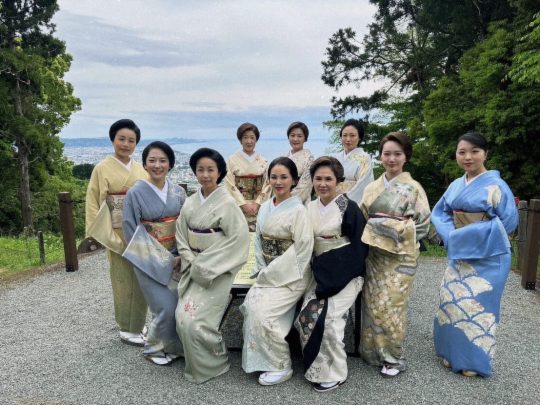
The look of… IX: Hakone-Yumoto Onsen
History Although it‘s likely that Geisha worked in Hakone since the late 19th century, not much can be found about their history. The current Kenban was built in 1950 [1]. In the early/mid 80's (before the bubble economy), 400-450 Geisha lived in Hakone [2]. The Otosan of Ikedaya Okiya reformed the traditional employment system and introduced benefits like pension plans and financial compensations for cancelled jobs [3].
In 2000 latest, the Hakone Yumoto Kenban launched its own website [4], creating a space for Okiya to advertise and look for new members [5]. In 2001, the Okasan of Wakita became the current head of the Geigi Union. In order to ensure the survival of local Hanamachi culture, the Kenban became open to public in 2008, and the Geisha band Basara (婆娑羅) was founded in 2009. [2]
In the late 2010's, around 150 Geisha from age 18 to 80 lived in 32 Okiya. Lack of work during the Corona pandemic reduced their numbers to 109 in 2021. The amount of Geisha working in Hakone has increased meanwhile, with 140 of them active in January 2024, but still hasn‘t reached its pre-pandemic levels. [2]

The look of Hakone Maiko
Local term: Kirariko きらり妓
※ Hairstyle: own hair, Shimada mage and Hanaogi mage ※ Kanzashi: Kushi, maezashi, non-seasonal hana kanzashi ※ Make up: western make up or light oshiroi, both lips painted from the start ※ Kimono: Furisode mostly without tucks (rarely with sleeve tucks) ※ Eri: white, white with embroidery (red, red/pink) ※ Obi: Koken musubi ※ Obiage: tied and tucked in, red ※ Obijime: red with simple, rectangular Obidome ※ Footwear: white or black Zori

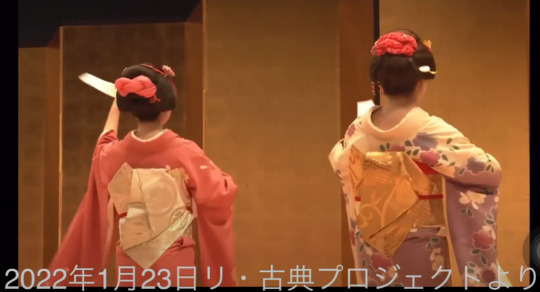
The look of Hakone Geiko
Local term: Geisha
※ Hairstyle: Taka shimada or Tsubushi shimada Katsura ※ Kanzashi: Taka shimada: Kushi, Tama in the back, Kogai in the back, and sometimes in the front too. Tsubushi shimada: Kushi, Tama ※ Make up: Oshiroi ※ Kimono: Mostly Homongi/Tsukesage, sometimes Hikizuri. Kuromontsuki for Tachikata is always a Hikizuri ※ Eri: white, rarely with white or pink embriodery ※ Obi: Yanagi musubi with Kuromontsuki (white/blue Hakata ori), otherwise Otaiko musubi ※ Obiage: always red with Kuromontsuki, otherwise white, pink or light blue. Usually not patterned. ※ Obijime: light-coloured. No Obijime with Yanagi musubi ※ Footwear: Zori, Geta with white or blue Hanao

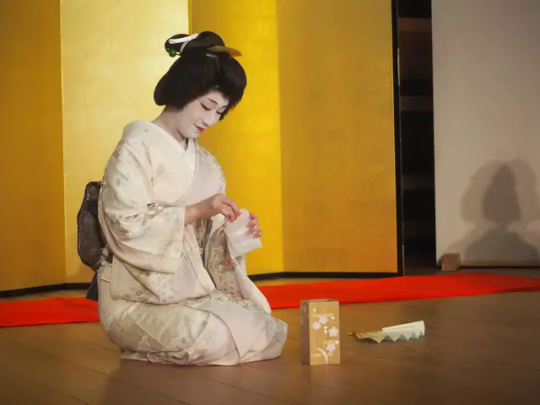
Casual/Jikata style
※ Hairstyle: Yohatsu ※ Kanzashi: usually none, maki (蒔絵) kanzashi at best ※ Make up: western make up ※ Kimono: Kurotomesode, otherwise Homongi ※ Eri: white ※ Obi: Otaiko musubi ※ Obiage: mostly warm pastel colours, but basically anything goes. Not patterned. ※ Obijime: Sometimes with Obidome ※ Footwear: Zôri

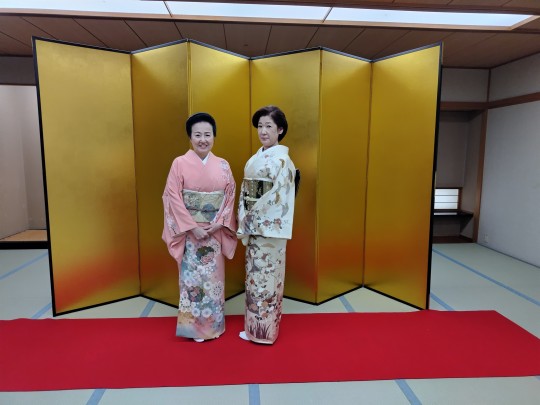

Tachiyaku style
※ Hairstyle: Maeware Katsura ※ Kanzashi: Tama pin in the back ※ Make up: Oshiroi ※ Kimono: Hômongi ※ Eri: white ※ Obi: Koken musubi with mint/light green Kakae Obi (抱え帯) ※ Obiage: red, white, pink or light blue. Obidome not uncommon ※ Obijime: light-coloured
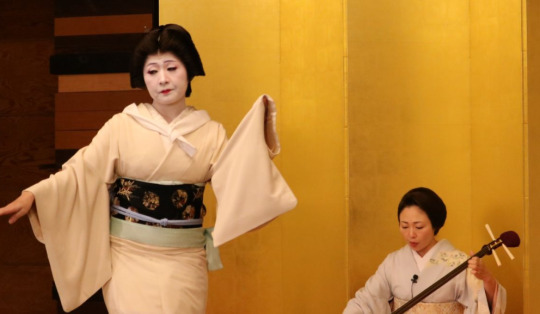
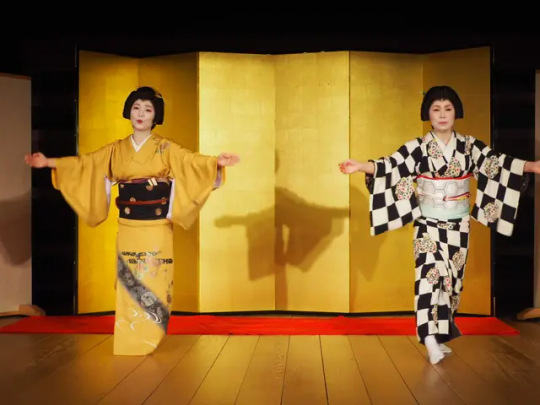
Notes
Arts: The schools taught in Hakone are Nishikawa 西川 (dance), Honjo 本條 (Kouta, Hauta and Min‘yo), Kineya 杵屋 (Nagauta) and Tosha 藤舎 (Hayashi). [6]
Kirariko is a newly coined term in use since 2003 to call junior Geisha in the age group from 18-30. [7] Upon turning 30, Kirariko have to take either a „dancer grade B“ or „dancer grade A“ test. To pass the B test, she has to perform two dances. For the grade A test, she has to perform three female style and three male style dances. [8]
Companions: Okiya recruit and employ companions as well as Geisha. Companions receive a fixed wage, which is usually lower than that of the Geisha, but the customer pays the same price. Companions can be requested to wear either western clothing or Kimono. Western clothing is a business suit provided for free by the Okiya, Kimono can be rented for a set fee by the Okiya as well. [9] Companions receive professional names like Geisha. They don‘t study performing arts and can work part-time. Their job is to serve drinks and food and engage in „pleasant conversation“ with customers at banquets. [10] In my opinion, a good entry-level job in the Karyukai – some companions became Geisha later in their carreer. [11]
Becoming independent: after being Geisha for seven years, you have the opportunity of opening a branch of your debut Okiya. In all cases I know, the new Okiya takes one or two characters from the original Okiya. For example Ikedaya 池田家 → Wakita 和喜田 and Yukieda 雪江田 (田 Kanji is part of the new name). Wakita 和喜田 → Suzuwa すず和 and Yukiwa ゆき和 (和). Kitami 㐂田見 → Kisaya 㐂茶家 (㐂).
Changing Okiya registration: only possible when becoming independent, or when your (biological) mother, sister, or daughter opens a new Okiya.
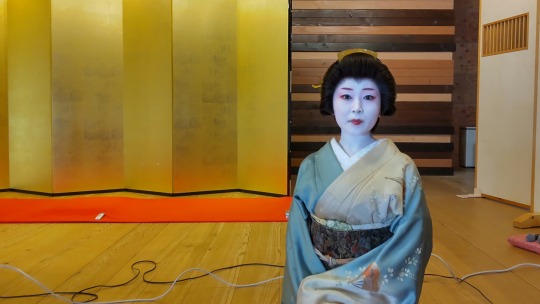
Sources
[1] https://note.com/meetgeisha/n/n1cc907ffd4c9. [2] https://www.tokyo-np.co.jp/article/301712, [3] https://conex-eco.co.jp/hakonesaisai/71824/ [4] https://web.archive.org/web/20000919171055/http://www.geisha.co.jp:80/ [5] https://web.archive.org/web/20001017234326/http://www.geisha.co.jp/okiya-name.htm,[6] https://geisha.co.jp/kenban/, [7] https://web.archive.org/web/20040408030159/http://www11.plala.or.jp/fukunoya/what_is_kirariko.html,[8] https://konohanasakuya.blogspot.com/2012/03/dance-performance.html,[9] https://yukieda.com/kyuujin_answer/, [10] https://yukieda.com/recruit/companion/,[11] https://web.archive.org/web/20080220191156/http://www.00wakita.com/hyousyou.html
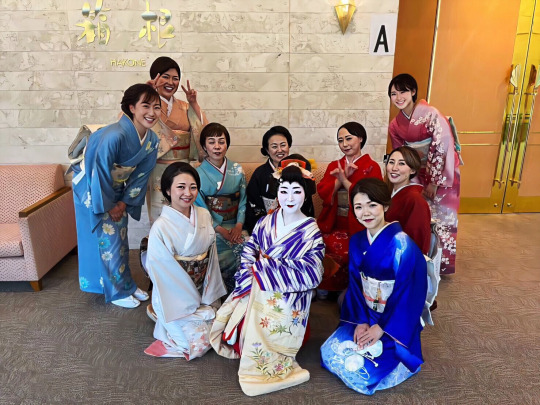
Picture sources: Group picture 2024, Hakone Odori, three Kirariko 2023, Kirariko back view 2023, Geisha dancing, Geisha preparing Tosenkyo set 2019, Sumomo with a dancer 2009, Anzu and Yuho 2023, really nice picture of Yumiko with Kokyu 2022, Chacha dancing 2022, Atsumi and unknown Tachikata 2019, Natsumi 2022, Matsuyoshi new year's picture 2023
69 notes
·
View notes
Text
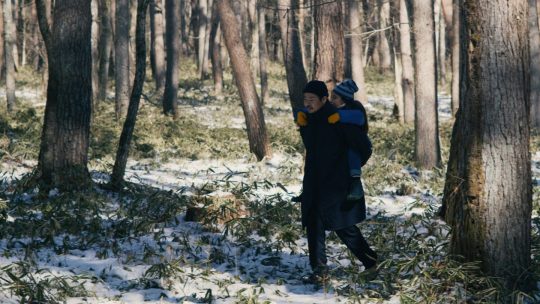
Hitoshi Omika and Ryo Nishikawa in Evil Does Not Exist (Ryusuke Hamaguchi, 2023)
Cast: Hitoshi Omika, Ryo Nishikawa, Ryuji Kosaka, Ayaka Shibutani, Hazuki Kikuchi, Hiroyuki Miura. Screenplay: Ryusuke Hamaguchi. Cinematography: Yoshio Kitagawa. Production design: Masato Nunobe. Film editing: Ryusuke Hamaguchi, Azusa Yamazaki. Music: Eiko Ishibashi.
I happen to agree with the title of Ryusuke Hamaguchi's film: Evil does not exist, or at least not as some demonic entity named Satan or Lucifer. What we call evil are manifestations of human frailty and fallibility like ignorance and greed. What makes Hamaguchi's movie so challenging is that he's able to state the case for, or at least not lay the blame for, both of those manifestations. There's a long historical precedent for doing so: As Thomas Gray put it back in 1747, "Where ignorance is bliss,/'Tis folly to be wise." More recently, we've had assertions that "greed is good," which is the underpinning of laissez-faire economics and the trickle-down theory. Hamaguchi takes a long slow time establishing the idyllic setting of a rural community and the apparently simple man named Takumi (Hitoshi Omika) who lives there with his small daughter, Hana (Ryo Nishikawa). Into this earthly paradise come representatives of corporate greed, Takahashi (Ryuji Kosaka) and Mayzumi (Ayaka Shibutani), who are tasked with persuading Takumi and the other residents of this rural community that it would be in their interest to allow their company to build a facility for glamping there. (Glamping is a pursuit that reminds me of the court of Marie Antoinette playing shepherds and shepherdesses at the Petit Trianon.) Takahashi and Mayumi are overwhelmed by the well-founded environmental objections to their company's proposal. Both of the corporate emissaries find the villagers' objections persuasive, but when they return to headquarters in Tokyo they're stonewalled by management and forced to return for another pitch, this time directed at Takumi himself. And so goes the setup for a moral tale that has no easy conclusion. And it doesn't get one: Hamaguchi chooses to end the film enigmatically. Evil Does Not Exist wasn't received as whole-heartedly as Hamaguchi's Oscar-winning Drive My Car (2021), and its slowness and ambiguity turned off some viewers, but it's a deftly characterized movie made with a capable cast of unknown actors, beautifully filmed with a haunting score by Eiko Ishibashi.
3 notes
·
View notes
Text
Eiko Ishibashi's Mournful Meditations

Eiko Ishibashi; photo by Shuhei Kojima
BY JORDAN MAINZER
When composing for film, singer-songwriter and musician Eiko Ishibashi knows how to both pull you in and shock you out of what you expect. Her latest fruitful collaborations have come with director Ryusuke Hamaguchi, Ishibashi first composing the score for Hamaguchi's 2021 film Drive My Car. Her musical cues tie into the narrative to the point where they're inexorably linked. I saw Drive My Car once when it came out, and every time I listen to its Original Soundtrack, I'm taken back to exactly the points in the film associated with each track.
Ishibashi and Hamaguchi's second collaboration, however, is a bit more complicated in terms of relationship between picture and sound. Hamaguchi was set to follow up Drive My Car with a 30-minute short silent film specifically designed to be screened with Ishibashi's live score. As he shot it, it grew into a full-length feature with dialogue, Evil Does Not Exist, with an accompanying score and soundtrack (out now via Drag City) from Ishibashi. Yet, Hamaguchi didn't totally scrap his original idea. Instead, he made a shortened, silent version of Evil Does Not Exist to go along with a live Ishibashi performance, entitled Gift. While it has a similar, if abridged plot to Evil Does Not Exist, viewing Gift is a different experience because it serves to emphasize the narrative power of Ishibashi's music.

Ishibashi; photo by Shuhei Kojima
When I saw a screening of Gift, accompanied by an Ishibashi performance, back in May at the Reva and David Logan Center for the Arts (presented by The Renaissance Society), I had not yet seen Evil Does Not Exist or heard the standalone soundtrack. I was familiar with the basic plot of both films: A development company wishes to build a glamping site in a rural village, much to the chagrin of its residents. Watching Ishibashi perform, I marveled at her ability to tell a story with a mix of sampled elements and live synths and woodwinds. Both films begin with skittering, jazzy cymbals and guitars (played by Ishibashi's partner Jim O'Rourke) before being cut off by the main swelling, dramatic string theme, sound-tracking a long, continuous skyward shot of forest trees in winter. Live, Ishibashi manipulated the sound of the orchestration, cutting it in and out, disorienting you when you got too used to the hypnosis of the shot. Likewise, in Evil Does Not Exist, the sound of footsteps slowly mixes in with the strings until they suddenly stop; at that point, you realize the camera is from the vantage point of a young girl, Hana (Ryo Nishikawa), walking through the woods, and the film goes on.
In both Gift and Evil Does Not Exist, we see characters on screen deep in their routines. It's almost therapeutic watching widower Takumi (Hitoshi Omika)--Hana's father--repeatedly chop wood, fill jugs with water from the stream, and pause for a cigarette. It's even more jarring, then, when these characters are taken out of their routines or beyond their comfort zones, like when Takumi suddenly stops his work because he realizes he's late to pick up Hana. Occasionally, we hear the sound of a distant gunshot as the villagers hunt for deer. During Gift, the booms were not far off from Ishibashi's bass thuds, but they certainly contrasted the light clicking of her pedals during quieter moments, just as they resemble a far cry from more "natural" sounds in Evil Does Not Exist, like the crunching of leaves and rushing water.
But more than challenging the repetitiveness of manual labor, in both films, the sound of a gunshot grows to symbolize the difference between rural and urban experiences. To pitch the glamping site to the villagers, the development company hires two talent agency representatives, Takahashi (Ryuji Kosaka) and Mayuzumi (Ayaka Shibutani), the latter of whom admits that the ringing blast was the first time she had ever heard a gun before. The two actors are, as we learn, clueless about the villagers' way of life, asking whether wild deer would be a threat to potential glampers (as opposed to the glamping site being an existential threat to the deer themselves). In one of the film's most tense scenes, Takahashi and Mayuzumi are put through the wringer when confronted by villagers' concerns about the effect of the glamping site's waste on the safety of their water supply. In Evil Does Not Exist, this scene is sound-tracked only by the stock music of the presentation before the characters start talking, suddenly cutting off. Gift, meanwhile, uses the scene to showcase the power of Ishibashi's compositions: We can feel the tension of the conversation by just hearing her score accompanied by only occasional words on screen.
As Takahashi and Mayuzumi shadow Takumi and help as much as possible with chopping wood, carrying water canisters, and so on, they become slightly more accustomed to the villagers' way of life and empathetic to their perspectives. They bluntly communicate the villagers' concerns to the project heads, who would rather rush through the project so as to keep their time-limited COVID subsidies. What happens from here, I will not spoil, though it's clear Hamaguchi's asking moral questions about the lengths people go to protect their loved ones and their surroundings, and whether or not the fight against capitalism is all-or-nothing. But during the scenes where the talent agency representatives are helping out, Ishibashi layers syncopated strings on top of the natural sounds, as if to blur the lines between humankind and the natural world, throwing even more wrenches into Hamaguchi's central queries.

Because Hamaguchi and Ishibashi render so complex the relationship between picture and sound via Gift and Evil Does Not Exist, the latter's soundtrack doesn't necessarily provide a new way to experience the projects' themes. Like that of Drive My Car, though, the soundtrack places you back in each scene. What's more, it exudes the films' distinctive moods. Of course, the opening and pseudo title track "Evil Does Not Exist v.2" consists of pattering drums and scraggly guitars giving way to the aforementioned solemn main string theme, squarely placing the film's beginning forest shot in your mind. The spacey synthesizer blips of "Hana V.2" make you picture the consistent wandering of its namesake character, the sound of thumping bass and footsteps making the listener feel an almost parental instinct when thinking about a child alone. And "Smoke" juxtaposes tactile and malleable instrumentation, a collection of cymbals, kick drum, woodwinds, and buzzing drones, the sonic manifestation of Hamaguchi's musings on the extent to which we can bend the world to suit our whims. Are we extensions of our surroundings, or have they become subservient to us? Does evil actually exist? Take in Hamaguchi and Ishibashi's multi-media world, and you'll have no answers, but certainly more to chew on while you, too, go about your every day.
#live music#eiko ishibashi#drag city#reva and david logan center for the arts#the renaissance society#evil does not exist#shuhei kojima#ryusuke hamaguchi#drive my car#gift#jim o'rourke#ryo nishikawa#hitoshi omika#ryuji kosaka#ayaka shibutani
2 notes
·
View notes
Text
Le Mal n'existe pas De Ryūsuke Hamaguchi Avec Hitoshi Omika, Ryo Nishikawa, Ryûji Kosaka
Takumi et sa fille Hana vivent dans le village de Mizubiki, près de Tokyo. Chronique : Ryūsuke Hamaguchi, connu pour ses œuvres acclamées telles que « Drive My Car » et « Asako I & II », revient avec « Le mal n’existe pas », un film qui confirme son statut de maître du cinéma contemporain. Avec des performances remarquables de Hitoshi Omika, Ryo Nishikawa, et Ryûji Kosaka, ce film est une…
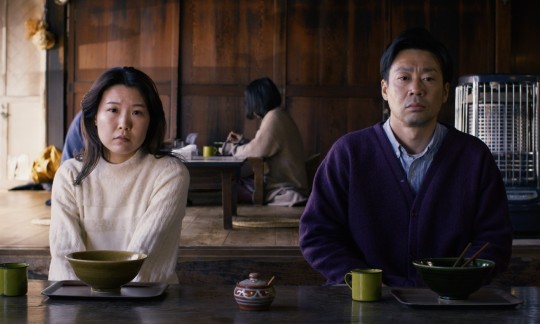
View On WordPress
0 notes
Photo

Screener Squad: Evil Does Not Exist EVIL DOES NOT EXIST MOVIE REVIEW Director/Writer Ryûsuke Hamaguchi won Global acclaim with the 2022 Oscar winning Best International Feature Film Drive My Car. His first follow up feature parks the car in the garage and takes us up to a secluded mountain paradise. Evil Does Not Exist follows Takumi (Hitoshi Omika) a single father and widower who lives in the peaceful village of Mizubiki. He, his young daughter Hana (Ryo Nishikawa), and the entire community have been invited to a meeting with a major corporation who wants to turn their perfectly balanced ecosystem into a glamping location. For those… Read More »Screener Squad: Evil Does Not Exist read more on One of Us
0 notes
Photo

Le mal n'existe pas, Hamaguchi continue d'explorer

Un film de Ryusuke Hamaguchi Avec: Hitoshi Omika, Ryo Nishikawa, Ryuji Kosaka, Ayaka Shibutani, Hazuki Kikuchi, Hiroyuki Miura, Yoshinori MiyataDans le village de Mizubiki, près de Tokyo, Takumi et sa fille Hana vivaient. Un jour, les habitants du village prennent connaissance d’un projet de construction d’un site de glamping près de la maison de Takumi, propose un habitant de la ville et cela affecte la vie de Takumi.
Retrouvez l'article complet ici https://lemagcinema.fr/films/good/le-mal-nexiste-pas-hamaguchi-continue-dexplorer/
0 notes
Text
Aku wa sonzai shinai
Aku wa sonzai shinai (2023) #RyusukeHamaguchi #HitoshiOmika #RyoNishikawa #RyujiKosaka #AyakaShibutani #HazukiKikuchi Mehr auf:
悪は存在しない / Evil Does Not ExistJahr: 2023 Genre: Drama Regie: Ryûsuke Hamaguchi Hauptrollen: Hitoshi Omika, Ryô Nishikawa, Ryûji Kosaka, Ayaka Shibutani, Hazuki Kikuchi, Hiroyuki Miura, Yoshinori Miyata, Taijirô Tamura, Yûto Torii … Filmbeschreibung: Takumi (Hitoshi Omika) und seine Tochter Hana (Ryo Nishikawa) leben im Dorf Mizubiki in der Nähe von Tokio. Wie Generationen vor ihnen führen sie…
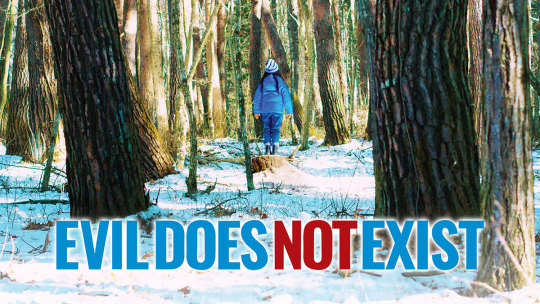
View On WordPress
0 notes
Text
IL MALE NON ESISTE, di Ryûsuke Hamaguchi con Hitoshi Omika e Ryo Nishikawa, 2023
Un film drammatico di Ryûsuke Hamaguchi (Drive my car,…) con Hitoshi Omika e Ryo Nishikawa – Giappone, 106 minuti. In una località boschiva non lontana da Tokyo, il tuttofare Takumi e sua figlia Hana, di otto anni, vivono in armonia con la natura e con i pochi abitanti del luogo. Una grande impresa dello spettacolo decide però di aprire un glamping, ovvero un camping con il glamour di un resort,…
youtube
View On WordPress
1 note
·
View note
Text
JUST FOUND THIS THING I WROTE???? WHAT THE FUVK real acvtually
"mihoko keeps kane conscious while she's killing - no, torturing him. it's quite entertaining ! kane, who up til this point had been so cool, so sure of himself, so full of confidence and snark and arrogance .... the kane who, now, has an expression of pure fear scarred permanently on his face, writhing and struggling under her grasp. she laughs at the way his body reacts to the pain - every hiss and flinch and shallow, rapid intake of breath drives her completely crazy. normally she'd go for a quick death. but this is kane cooper, and she thinks he deserves a much more enthralling show. she thinks she deserves to be entertained too !
she keeps him alive for as long as possible. one should never be too hasty! she watches as the life slowly drains out of him, his struggling slowly coming to a stop. he's barely alive at this point, a still-breathing corpse, and god, does she love it. she plans to drag this out as long as she can.
until he smiles at her. his green eyes are basically grey at this point, his every breath shaky and rattling, drained of all his livelihood... but still, he smiles at her. it's smug. it's arrogant. it's a winning smile - a smile that completely takes back all of the control he'd lost, a smile that mocks her, and suddenly she's enraged. absolutely enraged. she's had enough.
so she brings out hana.
and hana takes a knife and drives it into him, punctuating his entire body with wounds, mania and adrenaline coursing through her veins with every thrust. it's exhilarating!! absolutely exhilarating !! mihoko watches with a satisfied grin as her little puppet finishes him off...
it's such a shame, though, kane could have been her greatest masterpiece."
2 notes
·
View notes
Photo

EVENT UPDATE
The Bandai Namco Ent. Festival 2nd Live artists have been announced! The event will occur on the 6th and 7th of February 2021! All the idolm@ster brances will be appearing on both days (so the full cast list will be posted for posterity)
FEBRUARY 6TH STAGE
IDOLM@STER Cinderella Girls LOVE LAIKA: Aya Suzaki (Minami Nitta), Sumire Uesaka (Anastasia) ENJIN: Yuko Hara (Takumi Mukai), Mayumi Kaneko (Rina Fujimoto), Haruka Chisuga (Ryo Matsunaga), Tomo Muranaka (Aki Yamato), Kiyono Yasuno (Natsuki Kimura) Dimension-3: Kotomi Aihara (Shiki Ichinose), Shiki Aoki (Asuka Ninomiya)
IDOLM@STER Million Live Haruka Yamazaki (Mirai Kasuga), Azusa Tadakoro (Shizuka Mogami), Machico (Tsubasa Ibuki), Yukiyo Fujii (Megumi Tokoro), Kotori Koiwai (Tomoka Tenkubashi), Yuu Kahara (Emily Stewart), Megumi Toda (Ayumu Maihara), Rika Abe (Mizuki Makabe), Saki Minami (Tsumugi Shiraishi)
DEEN, misono, BACK-ON
Aikatsu! Aikatsu!/Aikatsu Stars!: Waka Kirishima, Ruka Endo, Sena Horikoshi, Risuko Sasakama, Rie Fujishiro Aikatsu Friends!: Akane Matsunaga (Aine Yuki), Ibuki Kido (Mio Minato) Aikatsu Parade!: Rin Aira (Raki Kiseki) Aikatsu Planet!: Kaya Date (Mao Otoha/Hana), Rio Ogura (Ruli Tamaki/Ruli), Mizuki (Ayumi Tsukishiro/Q-PIT), Shizune Nagao (Kyoko Umekoji/Beat), Rion Watanabe (Shiori Motoya/Shiori), Amy (Ann Kurimu/Ann), Narumi Uno (Meisa Hinata/Rose), Rurika Uno (Sala Itoi/Sala)
FEBRUARY 7TH STAGE
IDOLM@STER 765PRO ALL STARS Eriko Nakamura (Haruka Amami), Asami Imai (Chihaya Kisaragi), Mayako Nigo (Yayoi Takatsuki), Naomi Wakabayashi (Ritsuko Akizuki), Chiaki Takahashi (Azusa Miura), Rie Kugimiya (Iori Minase), Hiromi Hirata (Makoto Kikuchi), Akiko Hasegawa (Miki Hoshii)
IDOLM@STER SideM Café Parade: Sho Karino (Yukihiro Kamiya), Takuya Kodama (Makio Uzuki), Daiki Kobayashi (Saki Mizushima) S.E.M: Yoshiki Nakajima (Jiro Yamashita) THE Kogado: Junta Terashima (Takeru Taiga), Daiki Hamano (Michiru Enjoji) Legenders: Jun Kasama (Amehiko Kuzunoha), Fumiyoshi Shioya (Sora Kitamura), Wataru Komada (Chris Koron)
IDOLM@STER Shiny Colors Illumination Stars: Hitomi Sekine (Mano Sakuragi), Reina Kondo (Hiori Kazano), Mayu Mineda (Meguru Hachimiya) L’Antica: Karin Isobe (Kogane Tsukioka), Chisa Suganuma (Mamimi Tanaka), Anna Yamaki (Sakuya Shirase), Runa Narumi (Yuika Mitsumine), Mizuki Yuina (Kiriko Yukoku) Houkago Climax Girls: Mariko Nagai (Juri Saijo), Wakana Maruoka (Rinze Morino), Akiho Suzumoto (Natsuha Arisugawa) Alstoremeria: Honoka Kuroki (Amana Osaki), Ryoko Maekawa (Tenka Osaki), Noriko Shibasaki (Chiyuki Kuwayama) Straylight: Yuki Tanaka (Asahi Serizawa), Eri Yukimura (Fuyuko Mayuzumi), Sayaka Kitahara (Mei Izumi) Noctchill: Yuu Wakui (Toru Asakura), Rio Tsuchiya (Madoka Higuchi), Saran Tajima (Koito Fukumaru), Miho Okasaki (Hinana Ichikawa)
DENON-BU Sotokanda Literature: Yuuka Shidomi (Reina Hidaka LIVE set), Miho Amane (Kazyne Shinonome LIVE set), Sena Horikoshi (Futaba Kayano LIVE set) Jungumae Sandou: Yurie Kozakai (Mimito Sakurano LIVE set), Nichika Omori (Hina Minakami LIVE set), Rena Hasegawa (Shina Inubosaki LIVE set)
TAKANORI NISHIKAWA
LOVE LIVE! SCHOOL IDOL PROJECT AZALEA: Nanaka Suwa (Kanan Matsuura), Arisa Komiya (Dia Kurosawa), Kanako Takatsuki (Hanamaru Kunikida) Riko Sakurauchi&You Watanabe: Rikako Aida (Riko Sakurauchi), Shuka Saito (You Watanabe) Hanamaru Kunikida&Ruby Kurosawa: Kanako Takatsuki (Hanamaru Kunikida), Ai Furihata (Ruby Kurosawa) SAINT SNOW: Asami Tano (Sarah Kazuno), Hinata Sato (Leah Kazuno)
LOVE LIVE! NIJIGASAKI SCHOOL IDOL CLUB Aguri Onishi (Ayumu Uehara), Mayu Sagara (Kasumi Nakasu), Kaori Maeda (Shizuku Osaka), Miyu Kubota (Karin Asaka), Natsumi Murakami (Ai Miyashita), Tomori Kusunoki (Setsuna Yuki), Maria Sashide (Emma Verde), Chiemi Tanaka (Rina Tennoji), Moeka Koizumi (Shioriko Mifune)
12 notes
·
View notes
Photo

Picture Book, 'The Mirror of Flowers' (Ehon Hana No Kagami), Nishikawa Sukenobu, 1769, Brooklyn Museum: Asian Art
Size: 8 3/4 x 6 3/16 in. (22.2 x 15.7 cm) Medium: Book, woodblock color print on paper
https://www.brooklynmuseum.org/opencollection/objects/102732
3 notes
·
View notes
Text
AKB48 announced title for 57th single and coupling songs.
Title: Shitsuren , Arigato (Broken heart , Thank you).
B-Sides
Type A: Minegishi Minami graduation song (title to be announce)
Members:
Iwatate Saho, Kitazawa Saki, Komiyama Haruka, Minegishi Minami (Center), Mogi Shinobu, Mukaichi Mion, Murayama Yuiri, Okada Nana, Shinozaki Ayana.
Type B: 1st campus
Members:
Type B coupling song Senbatsu :
Asai Nanami (AKB48), Ando Chikana (NGT48), Chiba Erii (AKB48), Ishida Chiho (STU48), Kumazaki Haruka (SKE48), Matsuoka Hana (HKT48), Nishikawa Rei (AKB48), Omori Maho (AKB48), Oguma Tsugumi (NGT48), Suenaga Oka (SKE48), Suzuki Yuka (AKB48), Umeyama Cocona (NMB48), Unjo Hirona (HKT48), Yabushita Fuu (STU48), Yamamoto Ayaka (NMB48).
Type C: Team8 song ( title to be announce)
Members:
Oda Erina, Okabe Rin, Oguri Yui, Onishi Momoka, Kawahara Misaki, Gyoten Yurina, Kuranoo Narumi, Sakaguchi Nagisa, Shitao Miu, Nagano Serika, Yoshikawa Nanase
#akb48#team 8#ske48#nmb48#hkt48#stu48#ngt48#yamauchi mizuki#minegishi minami#okada nana#murayama yuiri#komiyama haruka#iwatate saho#mogi shinobu#mukaichi mion#kitazawa saki#shinozaki ayana
12 notes
·
View notes
Text
Danganronpa Next Gen
Basic Info on my DR Lovechildren for now. I will go in some details later for each of them :D
Class Hope
Hide Naegi - SHSL Psychologist - Makoto x Kyoko - Male - Straight (5′8)
Kokoro Maizono - SHSL Vocalist - Mukuro x Sayaka - Female - Straight (5′5)
Natsuo Ishimaru - SHSL Soccer Player - Kiyotaka x Leon - Male - Gay (5′9)
Hazuki Kuwata - SHSL Bassist - Kiyotaka x Leon - Female - Straight (5′4)
Setsuko Ishimaru - SHSL Conductor - Kiyotaka x Leon - Female - Straight (5′4)
Yoshiki Owada - SHSL Personal Trainer - Mondo x Chihiro - Male - Gay (6′0)
Mari Ludenberg - SHSL Playwright - Celestia x ??? - Female - Straight (5′2)
Taiyo Ogami - SHSL Lifeguard - Sakura x Aoi - Male - Straight (5′10)
Shiori Fukawa - SHSL Mangaka - Komaru x Toko - Female - Demi Bi (5′6)
Mitsuru Togami - SHSL Entrepreneur - Byakuya x ??? - Male - Aro Ace (6′1)
Asuka Hagakure - SHSL Tarot Reader - Hiro x Kanon - Female - Lesbian (5′3)
Class Future
Ryuji Kuzuryu - SHSL Vigilante - Hajime x Fuyuhiko - Male - Bi (5′8)
Saki Nanami - SHSL Game Developer - Chiaki (adopt) - Female - Straight (5′2)
Erika Nevermind - SHSL Horse Rider - Sonia x Akane - Female - Straight (5′7)
Raiden Nidai - SHSL Animal Trainer - Nekomaru x Gundham - Male - Gay (6′2)
Junpei Soda - SHSL Cameraman - Kazuichi (adopt) - Male - Bi (5′6)
Hanae Koizumi - SHSL Journalist - Mahiru x Sato - Female - Lesbian (5′3)
Choko Tsumiki - SHSL Physician - Peko x Mikan - Female - Demi Ace (5′9)
Soma Mioda - SHSL Rockstar - Ibuki x ??? - Male - Pan (5′8)
Nozomi Komaeda - SHSL Theorist - Nagito (adopt) - Non-binary - Bi (5′7)
Class Truth
Noriaki Saihara - SHSL Criminalogist - Shuichi x Maki - Male - Pan (5′7)
Eiko Amami - SHSL Explorer - Rantaro x ??? - Female - Lesbian (5′5)
Kensuke Momota - SHSL Astronomer - Kaito x Kaede - Male - Bi (6′0)
Kanade Momota - SHSL Violonist - Kaito x Kaede - Female - Straight (5′6)
Hiroto Oma - SHSL Spy - Kokichi (adopted) - Male - Gay (5′6)
Ayana Shirogane - SHSL Stylist - Miu x Tsumugi - Female - Pan (’5′7)
Kaori Chabashira - SHSL Jujustu Practionner - Tenko x Himiko - Female - Lesbian (5′5)
Yuri Chabashira - SHSL Witchcraft Practionner - Tenko x Hmiko - Female - Straight (5’1)
Tadashi Tojo - SHSL Host - Ryoma x Kirumi - Male - Homo Ace (6′0)
Sumire Shinguji - SHSL Spiritualist - Korekiyo x Angie - Female - Bi (5′6)
Hotaru Gokuhara - SHSL Gardener - Gonta (adopt) - Male - Straight (6′3)
Important background/other characters
Kojiro Munakata - Academy Director
Rinko Izayoi - Academy Cook
Chiyomi Kimura - Academy Doctor
Tomoki Nishikawa - Class Hope Homeroom Teacher
Kovit Singha - Tomoki’s husband and Main Gym Teacher
Kameko Hiragi - Class Future Homeroom Teacher
Hisami Ichinose - Class Truth Homeroom Teacher
Shiro Takano - Guidance Councelor
Suzu Takano - Shiro’s sister and Librarian
10 notes
·
View notes
Text
What’s In a Book? Part 29
While going through my collection I managed to find a few books that have yet to be featured on here yet. I decided to go with this one as, upon further review, I noticed that it actually contained a wealth of information that I had previously ignored ^^;
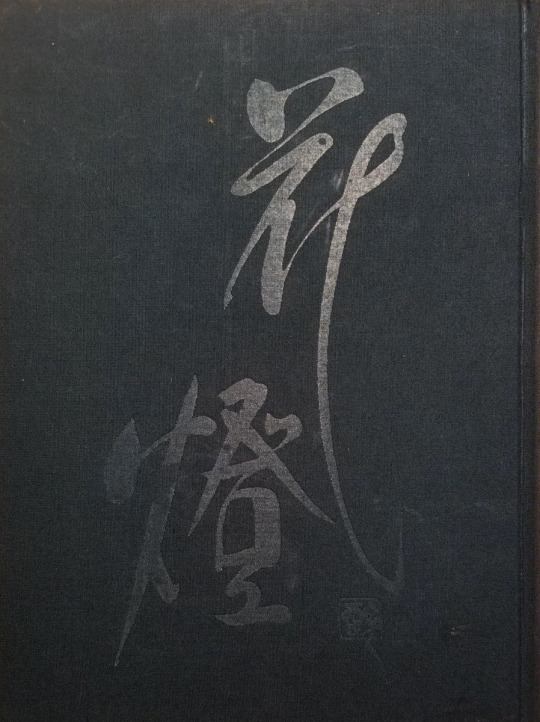
Image of book’s cover courtesy of myself. Hana Akari: Showa Meigiren (はなあかり: 昭和名妓連) - Brilliant Flowers: The Showa Period’s Finest Geisha by Kobunshi Katsura (桂小文枝) (ISBN Unknown). Date of Publication: 1988 Language: Japanese and English (Some Essays and Names Only) Format: Hardcover Availability: Can be found up for auction on a fairly regular basis Price: Anywhere from $30 - $80 Errors: 0 This book is interesting, and that’s putting it mildly. Basically, it provides us with some of the best raw data for its time: The names of the most prominent geisha in each district of each city across all of Japan. It is a literal who’s who guide to the karyukai across the country in the late 1980s and is illuminating both in small essays that can be found at the front and back of the book explaining various schools and styles, but especially because it provides us with images, most in full color, of these amazing women. The book overall is divided into regions which are then broken down further from there. The regions, cities, and districts of each named geisha are: Part 1: Hokkaido (北海道) Set 1: Asahikawa (旭川) - Kofune (小舟) Set 2: Sapporo (札幌) - Onobu (お信), Itoko (い登子), Izumi (いづみ), and Charako (茶良子) Set 3: Otaru (小樽) - Komomo (小桃), Mametarō (豆太郎), Kiku (㐂久), and Gorō (吾朗) Set 4: Muroran (室蘭) - Chonko (﹅子) Set 5: Hakodate (函館) - Nantoki (喃登希) and Kohide (小ひで) Part 2: Tohoku (東北) Set 1: Morioka (盛岡) - Tsutamaru (都多丸) Set 2: Hanamaki (花巻) - Kimiko (君子) and Keiko (桂子) Set 3: Aomori (青森) - Chame (茶目) Set 4: Yamagata (山形) - Kochō (小蝶) and Kinta (金太) Set 5: Akita (秋田) - Chiyogiku (千代菊) Set 6: Obara (小原) - Ikkyū (一休), Aki (秋), and Kogiku (小菊) Set 7: Fukushima (福島) - Sakura (さくら) and Hidemi (秀美) Part 3: Kanto (関東) Set 1: Takasaki (高崎) - Kiyoko (清子) Set 2: Kusatsu (草津) - Sankoma (三駒) and Harumi (春美) Set 3: Sarugakyo (猿ヶ京) - Kikutaro (菊太郎), Koshizu (小静) Set 4: Minakami (水上) - Yutaka (ゆたか) Set 5: Oyama (大山) - Kunika (くに香) Set 6: Tokyo (東京) - Fumie (冨美江) and Wakaryū (若龍) Set 7: Yugawara (湯河原) - Okame (お加目), Matsue (松栄), and Taeko (多恵子) Part 4: Chubu (中部) Set 1: Niigata (新潟) - Chiyogiku (千代菊) Set 2: Takada (高田) - Kazuko (加津子) Set 3: Shibata (新発田) - Renko (れん子) Set 4: Kamidayamadatogura (上山田戸倉) - Senryū (泉竜), Suzuyakko (鈴奴), Saizō (才三), and Utamaru (歌丸) Set 5: Kamisuwa (上諏訪) - Chiyomaru (千代丸) Set 6: Isawa (石和) - Miki (美樹) and Koyakko (小奴) Set 7: Kōfu (甲府) - Misako (美佐子), Kimika (君香), and Hisayo (久代) Set 8: Inuyama (犬山) - Misako (みさ子) Set 9: Hamamatsu (浜松) - Gonza (権三), Ichitarō (市太郎), Otomi (乙美), Koman (小萬), Eiko (栄子), Hatsutarō (初太郎), Tsuruchiyo (鶴千代), Yasuyo (泰世), Sakura (佐久良), Sachiko (幸子), Toshie (利枝), Komomo (小百々), Momoko (百々子), Fumiya (二三弥), Mitsugiku (光菊), Azuma (吾妻), Akiko (明子), and Ichiha (市羽) Set 10: Kanazawa Higashi/East (金沢東) - Koman (小まん) Set 11: Kanazawa Kazuemachi (金沢主計町) - Hitoha (一葉) and Kyōko (京子) Set 12: Kanazawa Nishi/West (金沢西) - Mineko (峯子), Sachiyo (幸代), and Marichiyo (まり千代) Set 13: Fukui (福井) - Makiko (真㐂子) and Yurako (由良子) Set 14: Yuzawa (湯沢) - Katsumaru (勝丸) and Hiromi (弘美) Set 15: Nagoya (名古屋) - Fukuchiyo (福千代), Takako (敬子), Tsuruko (つる子), Mitsuyo (光代), Kiku (喜久), Emiya (英美弥), Sanchō (三長), Satoyo (里代), Mitsu (未津), Ayako (あや子), Kinmaru (金丸), Naoe (直枝), Fukuwaka (福若), Hisae (比三枝), Mako (間子), Yasuko (康子), Toshino (とし乃), Koie (鯉恵), Mariko (まり子), Katsuko (かつ子), Maiko (舞子), Kingyo (金漁), Hideka (秀佳), Chiyoe (千代江), and Motoko (素子) Part 5: Kinki (近畿) Set 1: Osaka (大阪) Part A: Osaka Minami (大阪南) - Yukiharu (雪春), Kikutsuru (菊つる), Kikue (菊恵), Rikimaru (力丸), Kinko (きん子), Yukiji (ゆき路), Kōjirō (廣二郎), Yoshiko (よし子), Terugiku (照菊), Midori (美登利), Hankō (はん幸), Kazumi (かず美), Yukie (ゆき恵), Yūka (勇花), Suzuka (鈴佳), Masako (まさ子), Fukuemi (福笑), Masachiyo (政千代), Kikufumi (菊二三), and Yūko (祐子). Part B: Osaka Horie (大阪堀江) - Temari (てまり) Part C: Osaka Shinmachi (大阪新町) - Hatsuko (はつ子) and Tamao (玉緒) Part D: Osaka Kitashinchi (大阪北新地) - Komaka (駒香), Umesada (梅さだ), Umetomi (梅十三), Suzume (寿々女), and Umemitsu (梅充). Set 2: Kyoto (京都) Part A: Gion Kobu (祇園甲部) - Komame (小まめ), Hisae (久栄), Katsuyū (かつ勇), Haruyū (春勇), Miyokazu (美代一), Fukusono (フク園), Satoharu (里春), Yoshigiku (義㐂久), Kōsono (晃園), Teruha (照葉), Mamekō (まめ晃), Fukuyū (福勇), Kanoko (かの子), Machiko (真知子), Kumiko (玖見子), Kohana (子花), Takayū (孝友), Teruchiyo (照千代), Takeha (竹葉), Nakako (奈加子), Mameyū (まめ勇), Sonoko (その子), Tomichiyo (斗美千代), Yoshimame (芳豆), Kofumi (小富美), Kanoju (かの寿), Mamechiyo (豆千代), Katsufuku (かつ福), Mameji (豆爾), Toyochiyo (豊千代), Katsuji (佳つ二), Ichigiku (市季久), Mamezuru (まめ鶴), Koman (小萬), Michiko (道子), Miyokichi (美与吉), Aika (愛香), Teruyo (照代), Fumichiyo (富美千代), Kikuharu (菊春), Masuko (ます子), Momoko (桃子), Kosode (小袖), Chōji (長治), Tomigiku (冨菊), Komasu (小ます), Emiji (恵美二), Dan-e (だん栄), Koyū (小ゆう), Yukiryō (幸良), Hanachiyo (花千代), Miyuki (美ゆき), Masaru (勝), Kanoji (かの次), Hiromi (廣美), Kotomi (小とみ), and Ainosuke (愛之介). Part B: Pontocho (先斗町) - Miyofuku (美代福), Hisakō (久幸), Raiha (来葉), Momiha (もみ葉), Ichiko (市子), Shinatomi (���ナ富), Mameharu (豆治), Hisafumi (久富美), Ichisen (市扇), Mameyuki (豆幸), Umeyū (梅佑), Ichitoyo (市豊), Mameshizu (豆志津), Ichisono (市園), Mamechiyo (豆千代), Hisaroku (久ろく), Ichimitsu (市光), Momizuru (もみ鶴), Hide-e (英江), Tomizuru (富鶴), Emiju (笑寿), Fudeya (フデ哉), Miyosaku (ミヨ作), Ichihiro (市宏), and Shinateru (シナ照). Part C: Gion Higashi (祇園東) - Toyoji (豊治), Fumie (章栄), Chika (ちか), Tsurukazu (つる和), Tsunekazu (つね和), Tsunehisa (つね久), Masuko (ます子), Toyohisa (豊寿), and Masako (満佐子). Part D: Miyagawa Cho (宮川町) - Wakaharu (若晴). Kanae (叶恵), Fumichō (富美蝶), Mikiryū (三木竜), Wakachika (若千加), Fukukazu (ふく和), Toshiyū (敏祐), Suzuchiyo (鈴千代), Hinachō (雛蝶), Chikayoshi (千賀俊), Mieko (美恵子), Fukusome (冨久染), Tane-e (種栄), and Tanekazu (たね和). Part E: Kamishichiken (上七軒) - Tei (てい), Emi (恵美), Katsukiyo (勝㐂代), Tamafuku (玉福), Fukuzuru (福鶴), Hisazuru (久鶴), Tsuruzō (鶴三), Hisawaka (久若), Tamaryō (玉龍), Shimeyo (〆代), Katsumaru (勝丸), Naoko (尚子), Kokimi (小㐂美), and Kohan (小はん). Set 3: Nara (奈良) - Suzumi (須寿美) Set 4: Genrō (彦桹) - Kikuyū (菊勇) and Masaya (政弥). Set 5: Otsu (大津) - Omasa (おまさ) Set 6: Kinosaki (城崎) - Tomiyū (富勇) and Kanoko (佳乃子) Set 7: Wakayama (和歌山) - Kikuchiyo (菊千代) Set 8: Shirahama (白浜) - Tsutagiku (蔦菊) Set 9: Osaka Imasato (大阪今里) - Koito (小糸) and Kichihide (吉秀) Set 10: Imasato (今里) - Kichitama (吉玉) Set 11: Kyoto Shimabara (京都島原) - Hana Ōgi Tayū (花扇太夫) Part 6: Chūgoku (中国) and Shikoku (四国) Set 1: Tamatsukuri (玉造) - Naoko (尚子), Yae (八重), and Kishi (貴志). Set 2: Okayama (岡山) - Yakko (奴) and Chizu (知寿) Set 3: Takamatsu (高松) - Hamachiyo (浜千代) Set 4: Matsuyama (松山) - Ippei (一平) Set 5: Tokushima (徳島) - Fukuyo (福代) and Akiyo (明代) Set 6: Kochi (高知) - Kimiryū (君龍) and Sadamaru (貞丸) Part 7: Kyushu (九州) Set 1: Hakata (博多) - Mieko (美恵子) Set 2: Kurume (久留米) - Okiyo (お清) Set 3: Ureshino (嬉野) - Hisamatsu (久松), Komatsu (小松), Koshin (小新), Hisaryū (久竜), and Marikō (まり幸). Set 4: Isao (武雄) - Fumiya (文弥) Set 5: Beppu (別府) - Mitsugiku (光菊), Fujikatsu (ふじ勝), Umesono (梅園), and Tomiko (富子) Set 6: Kumamoto (熊本) - Ayako (あや子) Set 7: Kagoshima (鹿児島) - Aimaru (愛丸) The only areas that I noted are missing are some of the hot springs towns. I’m not too sure why they were skipped over, but it’s possible that the author did not have any connections to them. The most informative part that I admit I skipped initially is the small print under each geisha’s name: their natori specialty, natori teachers, and natori names. This means that we can trace back what schools were the main specialty of each region going back decades. Since this is invaluable for anyone studying geisha over time, I’ll write in what schools were followed, but I will keep names a secret. Districts are as follows: Part 1: Hokkaido (北海道) Set 1 Asahikawa (旭川) - Kineya (杵屋) Set 2: Sapporo (札幌) - Wakayagi (若柳) for dance and Tadeko (蓼胡) for song Set 3: Otaru (小樽) - Fujima (藤間) for dance and Tadeko (蓼胡), Kineya (杵屋), Kiyomoto (清元), Shunnichi (春日), and Tokiwazu (常磐津) for song. Set 4: Muroran (室蘭) - None Given Set 5: Hakodate (函館) - Tanaka (田中) for dance and Matsunaga (松永) for song. Part 2: Tohoku (東北) Set 1: Morioka (盛岡) - Tokiwazu (常磐津) for song. Set 2: Hanamaki (花巻) - Wakayagi (若柳) for dance and Kineya (杵屋) for song. Set 3: Aomori (青森) - None Given. Set 4: Yamagata (山形) - Fujima (藤間) for dance. Set 5: Akita (秋田) - None Given. Set 6: Obara (小原) - None Given Set 7: Fukushima (福島) - None Given. Part 3: Kanto (関東) Set 1: Takasaki (高崎) - Hanayagi (花柳) for dance and Okayasu (岡安) for song. Set 2: Kusatsu (草津) - Hanayagi (花柳) for dance. Set 3: Sarugakyo (猿ヶ京) - Kineya (杵屋) for song. Set 4: Minakami (水上) - Kineya (杵屋) for song. Set 5: Oyama (大山) - Kineya (杵屋) Set 6: Tokyo (東京) - Taguchiko (田口湖) for dance and Kineya (杵屋) for song. Set 7: Yugawara (湯河原) - Tanaka (田中) and Fujima (藤間) for dance and Tokiwazu (常磐津), Kineya (杵屋), and Tadeai (蓼相) for song. Part 4: Chubu (中部) Set 1: Niigata (新潟) - None Given. Set 2: Takada (高田) - None Given. Set 3: Shibata (新発田) - Okayasu (岡安) for song. Set 4: Kamidayamadatogura (上山田戸倉) - Bandō (坂東) for dance and Tōsha (藤舎), Shunnichi (春日), Kineya (杵屋), and Kiyomoto (清元) for song. Set 5: Kamisuwa (上諏訪) - Kineya (杵屋) for song. Set 6: Isawa (石和) - Hanayagi (花柳) for dance and Mochizuki (望月) for song. Set 7: Kōfu (甲府) - Hanayagi (花柳) for dance and Kiyomoto (清元), Okayasu (岡安), and Nagami (長巳) for song. Set 8: Inuyama (犬山) - Nishikawa (西川) for dance and Kineya (杵屋) for song. Set 9: Hamamatsu (浜松) - Fujima (藤間) and Fukuwara (福原) for dance and Kiyomoto (清元), Yoshimura (芳村), Shunnichi (春日), Nishikiharu (錦春), and Tokiwazu (常磐津) for song. Set 10: Kanazawa East (金沢東) - Kamizaki (神崎) for dance. Set 11: Kanazawa Kazuemachi (金沢主計町) - Fujima (藤間) for dance and Kineya (杵屋) and Mochizuki (望月) for song. Set 12: Kanazawa Nishi/West (金沢西) - Nishikawa (西川) for dance and Tōsha (藤舎), Okayasu (岡安), and Kashida (堅田) for song. Set 13: Fukui (福井) - Fujima (藤間) for dance and Utazawa (哥沢) for song. Set 14: Yuzawa (湯沢) - None Given. Set 15: Nagoya (名古屋) - Nishikawa (西川) for dance and Kiyomoto (清元), Tokiwazu (常磐津), Sumida (住田), Kineya (杵屋), Kishizawa (岸沢), Shunnichi (春日), and Fujimatsu (ふじ松) for song. Part 5: Kinki (近畿) Set 1: Osaka (大阪) Part A: Osaka Minami (大阪南) - Onoe (尾上), Fujima (藤間), Bandō (坂東), and Hanayagi (花柳) for dance and Kiyomoto (清元), Kondo (今藤), Mochizuki (望月) and Tokiwazu (常磐津) for song. Part B: Osaka Horie (大阪堀江) - Nishikawa (西川) for dance. Part C: Osaka Shinmachi (大阪新町) - Nishikawa (西川) for dance and Kineya (杵屋), Shunnichi (春日), and Ogie (荻江) for song. Part D: Osaka Kitashinchi (大阪北新地) - Nishikawa (西川) and Hanayagi (花柳) for dance and Kineya (杵屋), Tamura (田村), Uji (宇治), Tokiwazu (常磐津), Tagawa (田川), Kiyomoto (清元), and Yoshimura (吉村) for song. Set 2: Kyoto (京都) Part A: Gion Kobu (祇園甲部) - Inoue (井上) for dance. Part B: Pontocho (先斗町) - Onoe (尾上), Nishikawa (西川), and Wakayagi (若柳) for dance and Tōsha (藤舎), Kondo (今藤), Nakamura (中村), Ogie (荻江), Bungo (豊後), Kineya (杵屋), and Tokiwazu (常磐津) for song. Part C: Gion Higashi (祇園東) - Fujima (藤間) for dance and Tokiwazu (常磐津), Yanagi (柳), Nakamura (中村), Kineya (杵屋), and Tōsha (藤舎) for song. Part D: Miyagawa Cho (宮川町) - Umemoto (楳茂都), Wakayagi (若柳), and Rokugō (六鄕) for dance and Kondo (今藤), Bungo (豊後), Kiyomoto (清元), Yanagi (柳), Yamakishi (山岸), Utazawa (哥沢), Tadeko (蓼胡), and Umeya (梅屋) for song. Part E: Kamishichiken (上七軒) - Hanayagi (花柳) for dance and Tokiwazu (常磐津), Shunnichi (春日), Toyomoto (豊本), Kiyomoto (清元), Tōsha (藤舎), and Kiyoyuki (清之) for song. Set 3: Nara (奈良) - Kineya (杵屋) for song. Set 4: Hikone (彦桹) - None Given. Set 5: Otsu (大津) - Yanagi (柳) for song. Set 6: Kinosaki (城崎) - Wakayagi (若柳) and Onoe (尾上) for dance. Set 7: Wakayama (和歌山) - Onoe (尾上) for dance. Set 8: Shirahama (白浜) - Okayasu (岡安) for song. Set 9: Osaka Imasato (大阪今里) - Kineya (杵屋), Shunnichi (春日), and Kiyomoto (清元) for song. Set 10: Imasato (今里) - None Given. Set 11: Kyoto Shimabara (京都島原) - None Given. Part 6: Chūgoku (中国) and Shikoku (四国) Set 1: Tamatsukuri (玉造) - Fujima (藤間) for dance and Kineya (杵屋) for song. Set 2: Okayama (岡山) - Onishi (小西) for dance. Set 3: Takamatsu (高松) - Kiyomoto (清元) for song. Set 4: Matsuyama (松山) - Kiyomoto (清元) and Tamura (田村) for song. Set 5: Tokushima (徳島) - Yoshitō (芳膛) for dance and Kiyomoto (清元) and Tamura (田村) for song. Set 6: Kochi (高知) - Kiyomoto (清元) and Tamura (田村) for song. Part 7: Kyushu (九州) Set 1: Hakata (博多) - Kondo (今藤), Shunnichi (春日), and Kashida (堅田) for song. Set 2: Kurume (���留米) - Tokiwazu and Shunnichi (春日) for song. Set 3: Ureshino (嬉野) - Hanayagi (花柳) and Fujima (藤間) for dance and Matsunaga (松永) and Tagoto (田毎) for song. Set 4: Isao (武雄) - Fujima (藤間) for dance. Set 5: Beppu (別府) - Tokiwazu (常磐津), Kiyomoto (清元), and Hisago (瓢) for song. Set 6: Kumamoto (熊本) - Hanayagi (花柳) for dance and Kondo (今藤) for song. Set 7: Kagoshima (鹿児島) - Kineya (杵屋) and Tagoto (田毎) for song. The reason why this book has no ISBN is because it was self published. The original cover price was ¥30,000, which is almost $300 USD. This price was likely set due to the vast amount of research done, including acquiring the many photographs, and printing costs. This price was also likely due to it being targeted at serious karyukai connoisseurs as that price in the 1980s would have been much higher now due to inflation. Nowadays you don’t have to pay as much for this book as most Japanese sellers see it as outdated and it can be found quite regularly on Japanese retail sites, such as Yahoo Japan Auctions or Rakuten. The only “errors: that I could find were some spelling issues, but that’s because they’re using the Japanese way of writing Romaji and not the Hepburn System. So, I’m not counting them as errors, but rather just making note of them to anyone who purchases this book. Rating: ✪✪✪✪ (out of 5)
35 notes
·
View notes